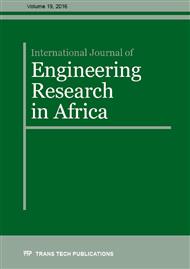[1]
I. A. Bella, A. Asroun & N. Bella, Effect of Curing Temperature on Mortar Based on Sustainable Concrete Material's and Poly-Carboxylate Superplasticizer. Journal of Civil Engineering and Architecture, 8(1), pp.66-72, (2014).
DOI: 10.17265/1934-7359/2014.01.008
Google Scholar
[2]
Bella Aguida Ilham, Aissa Asroun, Bella Nabil; Influence of limestone addition on mechanical properties of sand concrete : international seminar, INNOVATION & VALORISATION in CIVIL ENGINIRING, INVACO II, Mohammed V University, Agdal Rabat (2011).
DOI: 10.17265/1934-7359/2014.01.008
Google Scholar
[3]
Ismail Yurtdas, Nicolas Burlion, Frederic Skoczylas, Hydrous damage of cementious materials, in: 16th Mechanics French Congress, Nice, France, (2003).
Google Scholar
[4]
Jaques Baron and Raymond Sauterey, Hydraulic concrete practice and knowledge, the National school of bridges and roads Press, Paris, France, (1982).
Google Scholar
[5]
I. A. Bella, A. E. M. Hamouin, N. Bella, Influence of the temperature on compressive strength of crushed limestone sand concrete, in: Second International Conference on Sustainable Construction Materials and Technologies, Ancona, Coventry University and The University of Wisconsin Milwaukee Centre for By-products Utilization, Italy, (2010).
Google Scholar
[6]
Adam M. Neville, Concrete Property, Eyrolles edition, Paris, France, (2000).
Google Scholar
[7]
G. Dreux, New concrete guide, Eyrolles 8th edition, Paris, France, (1999).
Google Scholar
[8]
N. Bella, A. Asroun, I. A. Bella, Use of a New Approach (Design of Experiments Method) to Study Different Procedures to Avoid Plastic Shrinking Cracking of Concrete, Advanced concrete Technology, vol. 9 (2), pp.149-157. June (2011).
DOI: 10.3151/jact.9.149
Google Scholar
[9]
N. Bella, A. Asroun, & I. A. Bella, Effectiveness of Different Solutions to Reduce Plastic Shrinkage in Hot Climate Concreting : in: Second International Conference on Sustainable Construction Materials and Technologies, Ancona, Coventry University and The University of Wisconsin Milwaukee Centre for By-products Utilization, Italy, (2010).
Google Scholar
[10]
J. Plank, C. Schroefl, M. Gruber, M. Lesti, R. Sieber, Effecteness of poly-carboxylate superplasticizers in ultra-high strength conrete: The importance of PCE compatibility with silica fume, Journal of Advenced Concrete Technology 7 (1), pp.5-12, (2009).
DOI: 10.3151/jact.7.5
Google Scholar
[11]
R.J. Flatt, N.S. Martys, L. Bergstrom, The rheology of cementious materials, National Institute of Standards and Technology 29 (5), pp.314-318, (2004).
Google Scholar
[12]
H. Hilsdorf, J. Kropp, Performance Criteria for Concrete Durability, Taylor & Francis, London, (2005).
Google Scholar
[13]
P. D. Tennis, D. A. Thomas, J. Weiss, State-of-the-Arte Repot on Use of Limestone in cements at Levels of up 15%, Portland Cement Association, USA (2011).
Google Scholar
[14]
I. A. Bella, A. Asroun & N. Bella, Contribution to the amelioration of Mechanical Behavior of Mortar Based on limestone Mineral Admixture substitution at curing Temperature : international conference on civil and environmental engineering, Turkey (2015).
DOI: 10.15866/irece.v8i4.11135
Google Scholar


